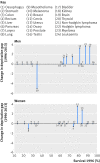Impact of national cancer policies on cancer survival trends and socioeconomic inequalities in England, 1996-2013: population based study
- PMID: 29540358
- PMCID: PMC5850596
- DOI: 10.1136/bmj.k764
Impact of national cancer policies on cancer survival trends and socioeconomic inequalities in England, 1996-2013: population based study
Abstract
Objective: To assess the effectiveness of the NHS Cancer Plan (2000) and subsequent national cancer policy initiatives in improving cancer survival and reducing socioeconomic inequalities in survival in England.
Design: Population based cohort study.
Setting: England.
Population: More than 3.5 million registered patients aged 15-99 with a diagnosis of one of the 24 most common primary, malignant, invasive neoplasms between 1996 and 2013.
Main outcome measures: Age standardised net survival estimates by cancer, sex, year, and deprivation group. These estimates were modelled using regression model with splines to explore changes in the cancer survival trends and in the socioeconomic inequalities in survival.
Results: One year net survival improved steadily from 1996 for 26 of 41 sex-cancer combinations studied, and only from 2001 or 2006 for four cancers. Trends in survival accelerated after 2006 for five cancers. The deprivation gap observed for all 41 sex-cancer combinations among patients with a diagnosis in 1996 persisted until 2013. However, the gap slightly decreased for six cancers among men for which one year survival was more than 65% in 1996, and for cervical and uterine cancers, for which survival was more than 75% in 1996. The deprivation gap widened notably for brain tumours in men and for lung cancer in women.
Conclusions: Little evidence was found of a direct impact of national cancer strategies on one year survival, and no evidence for a reduction in socioeconomic inequalities in cancer survival. These findings emphasise that socioeconomic inequalities in survival remain a major public health problem for a healthcare system founded on equity.
Published by the BMJ Publishing Group Limited. For permission to use (where not already granted under a licence) please go to http://group.bmj.com/group/rights-licensing/permissions.
Conflict of interest statement
Competing interests: All authors have completed the ICMJE uniform disclosure form at www.icmje.org/coi_disclosure.pdf and declare: no support from any organisation for the submitted work; no financial relationships with any organisations that might have an interest in the submitted work in the previous three years; no other relationships or activities that could appear to have influenced the submitted work.
Figures



Comment in
-
Cancer inequalities endure despite NHS reforms.BMJ. 2018 Mar 14;360:k989. doi: 10.1136/bmj.k989. BMJ. 2018. PMID: 29540364 No abstract available.
-
Improving cancer outcomes across Clinical Commissioning Groups.BMJ. 2018 May 17;361:k1903. doi: 10.1136/bmj.k1903. BMJ. 2018. PMID: 29773549 No abstract available.
-
Multidisciplinary team working contributes to lung cancer survival.BMJ. 2018 Jun 20;361:k1904. doi: 10.1136/bmj.k1904. BMJ. 2018. PMID: 29925606 No abstract available.
References
-
- Coleman MP, Babb P, Damiecki P, et al. Cancer survival trends in England and Wales 1971-1995: deprivation and NHS Region (Studies on Medical and Population Subjects No. 61). The Stationery Office, 1999.
Publication types
MeSH terms
Grants and funding
LinkOut - more resources
Full Text Sources
Other Literature Sources
Miscellaneous
